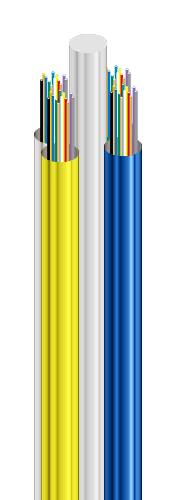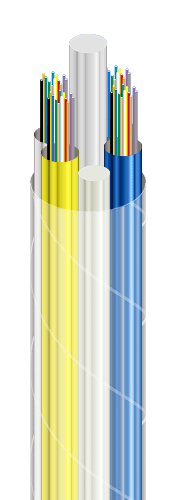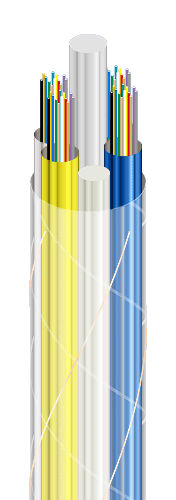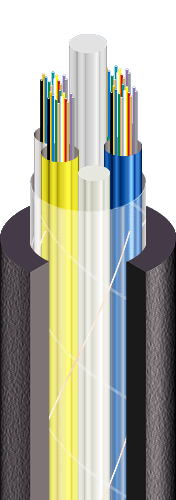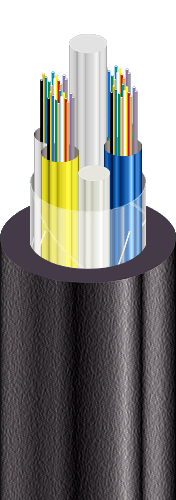ÎÀðÏíî * 6 – 3.5
ÒÓ Ó 31.3-00214534-036-2004 |
| Fiber optic module-core cables, aramid-yarn armoured, with polymer compound flame-retardant outer sheath |
| Mark formation: |
| ÎÀðÏíî-[a]-[b] [c]6([d]x[e]+[f])-3.5 |
| [a] central strength element |
| • C – steel |
| • No marks – dielectric |
| [b] quantity of optical fibers in the cable, possible values |
| • 4, 6, 8, 10, 12, 16, 18, 20, 22, 24, 28, 30, 32, 36, 40, 48, 60, 72, 78, 84, 90, 96 |
| [c] type of optical fiber |
| • E – single-mode (ITU-T G.652B) |
| • A – single-mode with extended wavelength band (ITU-T G.652D, ITU-T G.657A1) |
| • C – single-mode with non-zero shifted dispersion (ITU-T G.655) |
| • M – multimode with core and sheath diameter ratio 50 : 125 mm (ITU-T G.651) |
| • B – multimode with core and sheath diameter ratio 62.5 : 125 mm (IEC 60793-2) |
| [d] 1 ... 6 – number of optical modules in cable |
| [e] quantity of optical fibers in the module: |
| • 1 ... 16 |
| (f) quantity of insulated copper conductors in cable |
| Optical modules are completed with string fillers up to total number of core elements |
|
|
|
| Manufacturing of cables with two copper insulated remote power conductors instead of two string fillers is possible |
| Manufacturing of cables in climate version F is possible |
| It is possible to manufacture cables with gel-filled core or dry core (with water-blocking yarns and tapes) |
| It is possible to manufacture cables with a number of core elements up to and including 18 |
|
|
|
| Order placing: sample of indication (corresponds to configuration pattern) |
| ÎÀðÏíî-60A6(5x12)-3.5 • ÒÓ Ó 31.3-00214534-036-2004 |
|
|
|
| Cables are used for: |
| • installation in cable ducts, blocks, pipes, protection polyethylene pipes (including air installation method), without risk of damage by rodents |
| • in areas with exclusive fire safety requirements |
|
|
|
| Fire safety code in accordance with ÄÑÒÓ 4809:2007: ÏÁ101122000 |
| Products of this mark meet the requirements: |
| • single wire cable flame retardance |
| • toxicity class Tk1 of the combustion products of nonmetallic elements (toxicity index from 13 up to 40 g/m3) |
| • class ÄÒê1 on smoke-forming ability by smouldering of non-metallic elements (coefficient of smoke formation from 50 to 500 m2/kg) |
| • class ÄÏê2 on smoke-forming ability by combustion (minimum luminous flux more than 60 %) |
| • corrosive class Êê2 of combustion products of non-metallic elements (the number of halogen hydrides less than 150 mg/g, pH more than 4.3, specific conductivity less than 10 µS/mm) |




